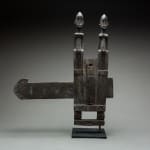Dogon Wooden Granary Door Lock, 19th Century CE - 20th Century CE
Wood
37.5 x 43.2 cm
14 3/4 x 17 in
14 3/4 x 17 in
PF.4411 (LSO)
This intriguing object is a granary door lock made by the Dogon group, Mali. It is a complex design that has at least 3,000 years’ of history in Northern Africa,...
This intriguing object is a granary door lock made by the Dogon group, Mali. It is a complex design that has at least 3,000 years’ of history in Northern Africa, notably Egypt. The body of the lock is a thick columnar bar, the apex of which is decorated with two seated figures – one male, one female – with their hands on their knees. The lock arrangement is the transverse bar which can be slid across to secure the door. The figures are traditionally Dogon, with domed heads and elongated torsos. There are two holes on the body of the lock that were used to attach it to the door. The inferior bars are decorated with crossed and hatching. The designs were not merely ornamental – they would have played a protective function, and warded off ill fortune while bestowing it upon anyone or anything that tried to steal from the granary. It has a patina from usage.
The Dogon live on the Bandiagara escarpment, Mali, a 150-mile-long eminence that supports a population of between 250,000 and 450,000. They have been described as the most studied and least understood tribal group in Africa. They are excessively prolific in terms of artistic production, not least because they have mastered all the main materials that are used in traditional African art; figures in stone, iron, bronze/copper and of course wood are all known, in addition to cave/rock painting and adaptation of more modern materials. Their profound resistance to Islam – which once sought to enslave them – is striking in light of their comparative proximity, and can be seen in their defiantly figurative artworks which are of course banned under Islamic law.
Their diversity has posed certain challenges to western art historians. There are around seventy-eight different mask forms still in production (in addition to numerous extinct variants), which are used in ceremonies for circumcision, initiation, funeral rites (damas) and cultic procedures. They also produce numerous sculptural forms, of males, females, hermaphrodites, nommos (ancestral spirits), animals and unidentifiable individuals that have maternity, apotropaic and ancestor functions. Even secular items are endowed with iconographic designs that bestow benedictions upon the user or owner; notable examples include headrests, granary doors/locks, house-posts and troughs.
Granaries were of primary importance to the Dogon. This piece would have secured the door to a granary that contained the livelihood of an entire family or small social group. It is a striking and attractive piece of secular African design, and a credit to any collection.
The Dogon live on the Bandiagara escarpment, Mali, a 150-mile-long eminence that supports a population of between 250,000 and 450,000. They have been described as the most studied and least understood tribal group in Africa. They are excessively prolific in terms of artistic production, not least because they have mastered all the main materials that are used in traditional African art; figures in stone, iron, bronze/copper and of course wood are all known, in addition to cave/rock painting and adaptation of more modern materials. Their profound resistance to Islam – which once sought to enslave them – is striking in light of their comparative proximity, and can be seen in their defiantly figurative artworks which are of course banned under Islamic law.
Their diversity has posed certain challenges to western art historians. There are around seventy-eight different mask forms still in production (in addition to numerous extinct variants), which are used in ceremonies for circumcision, initiation, funeral rites (damas) and cultic procedures. They also produce numerous sculptural forms, of males, females, hermaphrodites, nommos (ancestral spirits), animals and unidentifiable individuals that have maternity, apotropaic and ancestor functions. Even secular items are endowed with iconographic designs that bestow benedictions upon the user or owner; notable examples include headrests, granary doors/locks, house-posts and troughs.
Granaries were of primary importance to the Dogon. This piece would have secured the door to a granary that contained the livelihood of an entire family or small social group. It is a striking and attractive piece of secular African design, and a credit to any collection.
Provenance
Acquired from the Herbert Baker Collection in 1976, Chicago.



